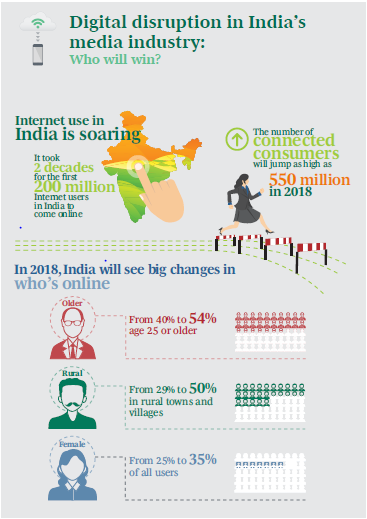Fast-rising digital penetration and use along with massive and far-reaching shifts in India’s digital-user base mean big changes for marketing and media companies.
According to a report released today by The Boston Consulting Group [BCG], Digital India: Insights for Marketers and Media Companies, there will be as many as 550 million connected consumers—40 percent of the population—in 2018. Equally significant are the changes taking place in who these consumers are and how they are using their devices. The report is based on two recent consumer surveys by BCG’s Center for Consumer and Customer Insight.
Some interesting insights of the report below:
- Users are getting older. In 2013, 40 percent of users were 25 years old or older; in 2018, 54 percent will be 25 or older. Because older users have more disposable income, they will likely transact more online.
- More users will live in rural areas. In 2013, 29 percent of users lived in rural areas; in 2018, approximately half will reside in smaller towns and villages. This will open up significant growth opportunities for marketers and service providers that keep in mind the dynamics of the rural market in India, such as using online distribution through e-commerce to ensure wider product availability.
- The user base will include more women. In 2013, 25 percent of users were female; in 2018, women will represent a third of all users. The increasing gender parity will have a major bearing on the Internet economy—women control 44 percent of household spending in India.
- The ways in which consumers use the Internet are also changing. Mobile connections will increase from 60 to 70 percent in 2013 to 70 to 80 percent in 2018. A majority of Indians who embrace the Internet, particularly rural consumers, have bypassed the PC and are using mobile devices to get online on the go. Some 70 percent of rural users access the Internet from their mobile handsets.
- Content will become more vernacular as the user base diversifies and grows to include larger numbers of rural consumers. The use of vernacular content online is estimated to increase from 45 percent in 2013 to more than 60 percent in 2018, mirroring broadening consumption patterns in off-line media such as print and television.
- Consumption is becoming a shared experience for many. Social interaction, pictures, blogs, and videos are growing in importance. Websites and apps such as Google, Facebook, and YouTube are often the first destination for digital consumers.
- Shifting digital use also has a strong impact on media consumption, with usage increasing as users gain digital maturity and as more content options become available. Consumers who have been online less than a year spend 30 percent of their media-consumption time on their devices, but after a year the percentage of digital consumption jumps to 34 percent, and after three years, it jumps again, to 39 percent. Those with more than five years of digital experience spend 42 percent of their media-consumption time on digital devices. This shift comes primarily at the expense of television. Print consumption remains relatively constant as digital consumption increases.
Speaking about the report, Nimisha Jain, a BCG Partner & Co-Author of the report said
Marketers have an opportunity to engage with consumers in new and powerful ways and to develop new offerings based on clearly identified user groups
Marketers that fully embrace the changes taking place can go even further and craft offerings that address the personal preferences of micro-segments or even individuals, on the basis of data that defines their online behavior
Kanchan Samtani, a BCG partner and co-author of the report said
The question for publishers and electronic-media companies alike is one of opportunity. Can publishers translate off-line print dominance into digital attraction? Can print and TV companies stake out digital territory with ancillary genres in the short term and core news genres in the long term so that they maintain loyalty and relevance with existing readers and viewers as well as attract new ones ? Or, if they do not move quickly enough, will they cede audience to digital upstarts ?
A copy of the report can be downloaded from here
About bcgperspectives.com
Bcgperspectives.com features the latest thinking from BCG experts as well as from CEO’s, academics, and other leaders. It covers issues at the top of senior management’s agenda. It also provides unprecedented access to BCG’s extensive archive of thought leadership stretching back 50 years to the days of Bruce Henderson, the firm’s founder and one of the architects of modern management consulting.


